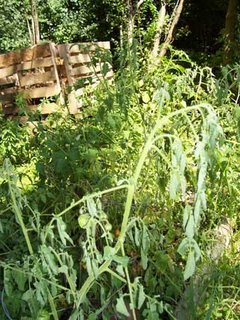I’m Sorry, Mr. Lycopersicon. It’s Verticillium Wilt and it’s Fatal
 In the soap opera that is my vegetable garden, the writers have decided that yet another character needs to develop a fatal disease and die. Several tomato plants have begun to show signs of Verticillium Wilt.
In the soap opera that is my vegetable garden, the writers have decided that yet another character needs to develop a fatal disease and die. Several tomato plants have begun to show signs of Verticillium Wilt.
And the worst part is I knew it was there. I just didn’t want to admit it.
Last year a single tomato plant in that bed died with all the signs of Verticillium Wilt but as it was one and as it was a determinate tomato, I tried to pretend it died because the fruit had set. But somewhere in the back of my mind, I knew what I was dealing with.
And for my defense, I would like to point out that I did not plant tomatoes in that bed this year. They planted themselves. This year, I planted peas in that bed and when the peas were done, I let the volunteer tomatoes take over. And now they are dying.
With any wilt, a major clue that your plants are infected is that… drumroll please… they wilt. Boy, we gardeners are not one for creative names. In this case, I know I have wilt rather than failure to water because it downpoured last night. These plants were well watered and still they look like they have not been watered in 2 weeks.
Tomato wilt tends to occur in two forms. Either Fusarium Wilt or Verticillium Wilt. The easiest way to tell the difference is to think of the two like the difference between a stroke and a heart attack. Fusarium tends to hit just one side of the plant (like a stroke) and Verticillium hits the whole plant (like a heart attack).
In my case, the whole plant is wilted so I am pretty sure that it is Verticillium Wilt. The wilting is also happening late in the season. Fusarium Wilt tends to show up earlier in the season.
On top of that, a history of the bed tells me that only one plant was infected last year, so that plant was most likely infected before I even planted in my garden. Verticillium is a common greenhouse disease and I probably brought it home to my beds in that one plant.
Both kinds of wilt are a fungus that grows in the soil. The funguses attack the vascular system of the plant, making it difficult for the tomato plant to bring water up out of the soil. As the vascular system of the plant collapses, the plant dies.
What makes either wilt even more frustrating is that its onset can be accelerated by overwatering. So when you see the wilted leaves and your gut instinct is to water the plant… this only makes the problem worse. That is one clever survival adaptation on the part of the funguses, if you ask me.
One the tomato is infected, the disease is fatal.
Now, if you find yourself with either wilt in your tomatoes, DON’T PANIC. You have some choices.
You can just leave the plants there for the season. They will still produce fruit until the bitter end. The fruit won’t be as big, but the plant at least won’t be a loss. The wilt funguses are not harmful to humans.
You can rip the plants up right away. It won’t help to get rid of the fungus but it will make it so you can solarize your soil this year, rather than letting the beds sit fallow for a year.
Make sure that you do not compost any of the infected tomato plants. They go into the trash.
Your next step is to decide what to do with the bed. You will need to either keep tomatoes and any of their relatives (potato, tomato, pepper, eggplant) out of the bed for a few years or you will need to solarize the bed, preferably for 4-6 weeks in hot weather. If it is not done now, then you should let the bed sit fallow for a year while you solarize it.
Me personally, I am going to let the plants grow. They were volunteers after all and they do have a few tomatoes growing on them. Once the plants have died, I will solarize the bed. I am going to try doing it early in the season next year and I will use it for carrots and radishes for the rest of the season.

I was inspired by the “yes, you can leave a comment on a gardening blog!” post, so . . . great post on tomato wilts. Concise yet informative. 🙂
I am doing research for a class on Verticillium wilt. It is not supposed to be fatal. The Fusarium wilt is. The V.wilt is the one that affects one side. The V.wilt infects the plants when the soil is moist and cool. F.wilt perfers it a little warmer. My sources are ohioline.osu.edu and Cornell Univ. fact sheets.
Thanks for the information. I’m not particular on which wilt this is, as long as I know what’s wrong with my plants! I searched all over, and this article gives me the best information about my options. I’m glad to know that pulling up the plants won’t necessarily save the tomatoes right next to them, since I really didn’t want to go kill off my babies. Even if they are going to die anyway.
Pingback: Juliet Tomato: Hanna’s Tomato Tastings 2010